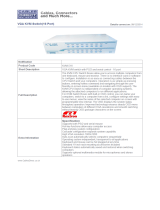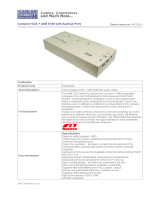
13
Function key <F2>: To switch the eye mark (1) of a computer on
or off. First, use the <UP> and <DOWN> arrow keys to highlight it,
then press <F2> to switch its eye mark on or off. If Scan Type is
'Ready PC +
1', only the power-on and eye mark selected
computers will be displayed sequentially in Scan mode.
Function key <F3>: To lock a computer from unauthorized access.
To lock a device, highlight it then press <F3>. Now, enter up to 4
characters (‘A’~’Z’, ‘0’~’9, ‘-‘) followed by <ENTER> as new password.
A Security-enabled device is marked with a lock (±) following its port
number. To permanently disable the security function from a locked
device, highlight it, press <F3> then enter the password. For a 4-port
KVM switch, only one port can be locked by password.
If you want to access the locked device temporarily, simply highlight it
and press <ENTER>, the OSD will ask you for the password. After
entering the correct password, you are allowed to use the device.
This device is automatically re-locked once you switch to another port.
During Scan mode, OSD skips the password-protected devices.
If you forget the password, the only way to permanently
erase all the passwords is to:
Press and hold the front panel buttons “1” and “2”, then hold
“7” and “8”. Release “7” and “8”, then release “1” and “2”.
For 4-port KVM switches: If you forget the password, the only
way to permanently disable the security function is to remove
all possible power sources from the master KVM switch. You
need to turn off all computers and unplug the power adapter,
then restart everything.
Function key <F4>: More functions are available by hitting <F4>. A
new screen pops up displaying more functions as described below.
Most of them are marked with a triangle () indicating there are
options to choose from. Using the <UP> and <DOWN> arrow keys,
select the functions and press <ENTER>. Available options will be
14
shown in the middle of the screen. Again, using the <UP> and
<DOWN> arrow keys to view options then press <ENTER> to select
it. You can press <ESCAPE> to exit at any time.
Auto Scan
In this mode, the Integra automatically switches from one
power-on computer to the next sequentially in a fixed interval.
During Auto Scan mode, the OSD displays the
name of the selected computer. When Auto Scan detects
any keyboard or mouse activity, it suspends the scanning till
activity stops; it then resumes with the next computer in
sequence. To abort the Auto Scan mode, press the left
<CTRL> twice, or, press any front button. Scan Type and Scan
Rate set the scan pattern. Scan
Type (<F4>:More\Scan Type) determines if scanned computers
must also be eye mark selected. Scan Rate (<F4>:More\Scan
Rate) sets the display interval when a computer is selected
before selecting the next one.
Manual Scan
Scan through power-on computers one by one by keyboard
control. can Type (<F4>:More\Scan Type) determines if scanned
computers must also be eye mark selected. Press the up arrow
key (↑) to select the previous computer and the down arrow key
(↓) to select the next computer. Press any other key to abort
the Manual Scan mode.
Audio Stick
An optional multimedia module can be LINKed to the back of
each Integra KVM switch for selecting microphone and stereo
speaker signals. There are two options for Audio Stick: ON and
Off. When set to 'On', audio selection follows computer selection.
When set to 'Off', audio selection stops following computer
selection. It is useful if you want to listen to a particular
computer's audio signal while operating other computers. The
non-volatile memory stores the Audio Stick setting.

















